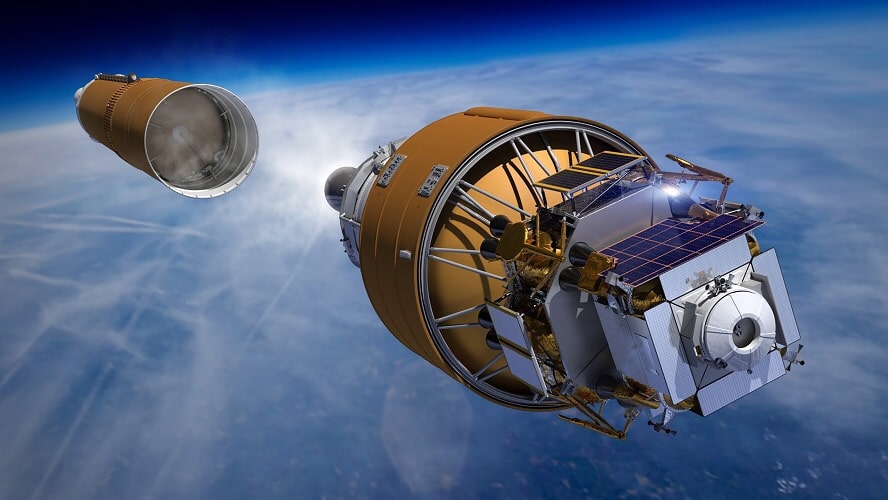Aviation
Boeing Proposes ‘Fewest Steps to the Moon’ for NASA’s Human Lander

HOUSTON, Nov. 5, 2019 — Boeing [NYSE: BA] today submitted a proposal to NASA for an integrated Human Lander System (HLS) designed to safely take astronauts to the surface of the moon and return them to lunar orbit as part of the Artemis space exploration program.
Boeing joins $37 million investment in British rocket firm Reaction Engines
The company’s proposal calls for delivering the lander’s Ascent Element and Descent Element to lunar orbit in one rocket launch to ensure it is tailored for maximum capability and crew safety. This approach reduces the complexity and risk of sending multiple segments to orbit on multiple launches, enabling a crewed lunar surface landing with only five mission critical events instead of the 11 or more required by alternate strategies. Boeing’s integrated lander also can carry itself from lunar orbit to the surface without an additional transfer stage or “space tug,” further reducing launches and simplifying the steps to a successful landing.
“Using the lift capability of NASA’s Space Launch System (SLS) Block 1B, we have developed a ‘Fewest Steps to the Moon’ approach that minimizes mission complexity, while offering the safest and most direct path to the lunar surface,” said Jim Chilton, senior vice president of Space and Launch for Boeing Defense, Space & Security.
Boeing to deliver additional MH-47G Block II Chinooks to U.S. Army
Boeing’s design relies on NASA’s exploration backbone, the SLS rocket currently in production at NASA’s Michoud Assembly Facility (MAF). The SLS has an unmatched lift capability that builds on proven flight components. This approach shortens development time and lowers risk, enabling NASA to safely land on the moon’s surface by 2024.
The lander’s flexible design allows for the fastest path to lunar flights while providing a robust platform that can perform NASA’s full range of exploration missions. It can dock with the Gateway lunar orbiter or directly with NASA’s Orion to eliminate the need for an additional spacecraft, both on time to meet the 2024 mandate.
Boeing Starliner Completes First Orbital Flight Test with Successful Landing
The design includes innovations in its engines, composites, and automated landing and rendezvous systems. Key technologies are based on the Boeing CST-100 Starliner spacecraft, which will be fully demonstrated and proven during its upcoming Orbital Flight Test to the International Space Station in December 2019.
Plane’s cockpit window ripped out at 32,000ft forcing emergency landing
Boeing partnered with NASA’s Marshall Space Flight Center, Johnson Space Center, and Kennedy Space Center and will collaborate closely with NASA to integrate, certify, and operate this innovative HLS. The company also will provide the critical resources and industry knowledge required to ensure on-time delivery in support of a 2024 lunar landing. Whether serving in NASA’s 2024 or 2025 mission slot, Boeing’s approach maximizes return from agency investments in previous and ongoing programs to allow for the simplest and therefore highest probability path back to the lunar surface.

Aviation
Boeing, Antonov to Collaborate on Defense Projects

– MOU represents Boeing’s commitment to work with Ukrainian industry
– Includes exploring opportunities for collaborating on in-country support of Unmanned Aerial Systems
A Memorandum of Understanding was signed today by Boeing and Antonov Company to investigate potential collaboration on defense-related projects.
“We’re happy to keep collaborating with the Antonov Company to help Ukraine’s economic development and expansion,” stated Ted Colbert, CEO and president of Boeing Defence, Space, & Security.
Airbus and the Antonov An-225: The Best Partnership:Click here
“This agreement demonstrates our ongoing efforts to find more opportunities to work with Ukrainian industry, which was underscored by our signing of the Ukrainian Defence Industry Compact earlier this year.”
The areas of potential collaboration identified in the agreement consist of training, logistical support and overhaul services for tactical Unmanned Aerial Systems utilized by the Ukrainian Armed Forces, which includes the ScanEagle. In addition, the companies will also explore opportunities for Antonov to provide engineering support to Boeing.
The six largest cargo aircraft ever built in the aviation industry:Click here
“A strong, innovative, and efficient defense industry is key to sustainable economic development and national security, and we are extremely excited to collaborate with Boeing,” said Ievhen Gavrylov, CEO of Antonov Company.
This agreement brings a whole new level of opportunity to implement the latest and most effective solutions – in addition to the possibility of future projects with Boeing in the aerospace and defense industry.”
-

 Travel1 week ago
Travel1 week agoAir India to Expand US Operations with Three New Routes After a Decade
-

 Travel2 weeks ago
Travel2 weeks agoWhy We Should Avoid These Stamps in a Passport
-

 Airlines1 month ago
Airlines1 month agoInvestigations Reveal Fake Chinese Titanium in Boeing and Airbus Jets
-

 Tech4 weeks ago
Tech4 weeks agoChina’s CATL Plans 1,800-Mile Electric Plane Launch by 2027
-

 Airport3 days ago
Airport3 days agoTop 10 Largest Airports in the World by Size
-

 Aerospace4 weeks ago
Aerospace4 weeks agoChina’s Fighter Jets Turn Wings into Autonomous Drones
-

 Airlines4 days ago
Airlines4 days agoAir India Rolls Out A350s for Delhi-New York JFK and Newark Routes
-

 Defence3 weeks ago
Defence3 weeks agoBoeing Enhances Chinook with New Engines and Block II Upgrades at $96 Million







